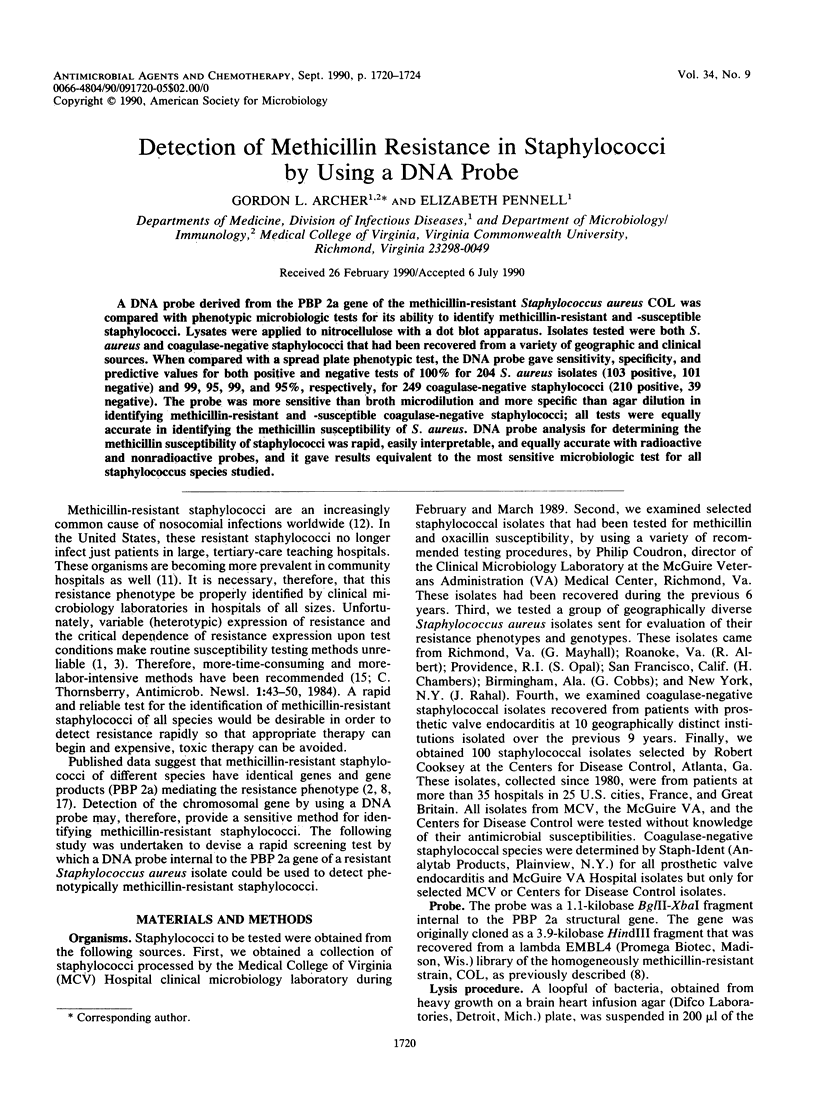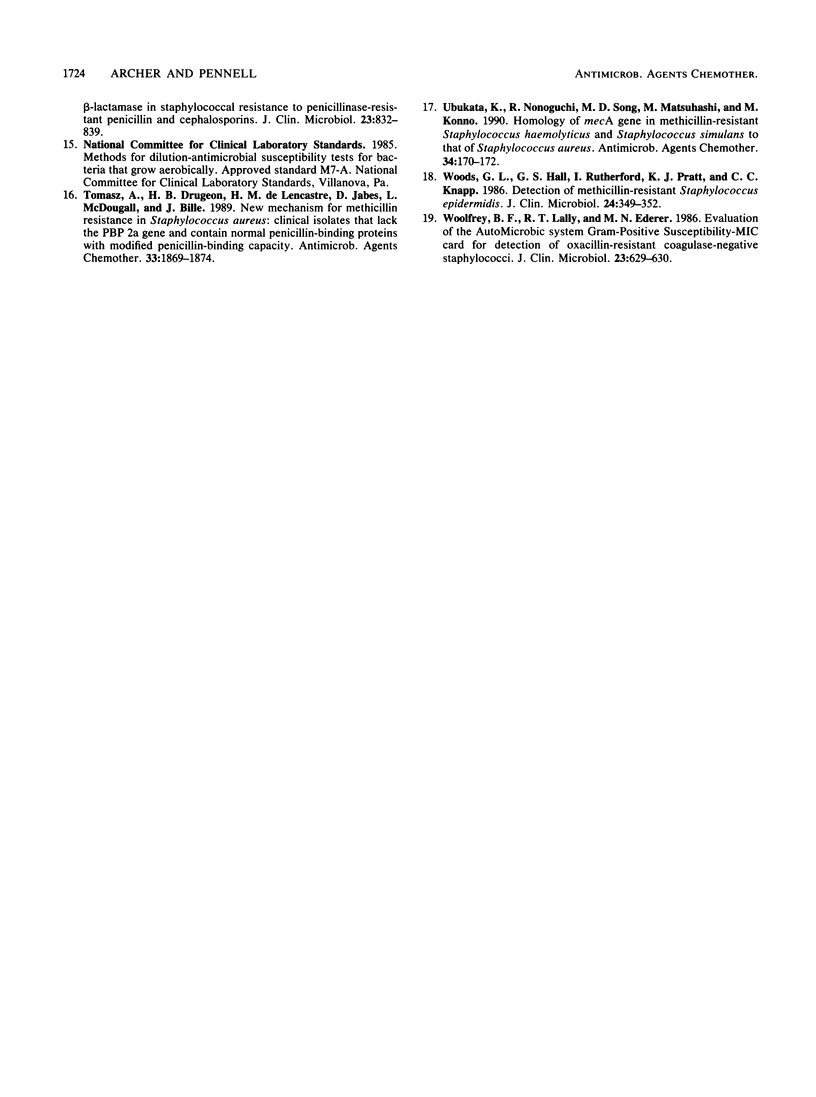Abstract
A DNA probe derived from the PBP 2a gene of the methicillin-resistant Staphylococcus aureus COL was compared with phenotypic microbiologic tests for its ability to identify methicillin-resistant and -susceptible staphylococci. Lysates were applied to nitrocellulose with a dot blot apparatus. Isolates tested were both S. aureus and coagulase-negative staphylococci that had been recovered from a variety of geographic and clinical sources. When compared with a spread plate phenotypic test, the DNA probe gave sensitivity, specificity, and predictive values for both positive and negative tests of 100% for 204 S. aureus isolates (103 positive, 101 negative) and 99, 95, 99, and 95%, respectively, for 249 coagulase-negative staphylococci (210 positive, 39 negative). The probe was more sensitive than broth microdilution and more specific than agar dilution in identifying methicillin-resistant and -susceptible coagulase-negative staphylococci; all tests were equally accurate in identifying the methicillin susceptibility of S. aureus. DNA probe analysis for determining the methicillin susceptibility of staphylococci was rapid, easily interpretable, and equally accurate with radioactive and nonradioactive probes, and it gave results equivalent to the most sensitive microbiologic test for all staphylococcus species studied.
Full text
PDF




Selected References
These references are in PubMed. This may not be the complete list of references from this article.
- Barry A. L., Jones R. N. Reliability of high-content disks and modified broth dilution tests for detecting staphylococcal resistance to the penicillinase-resistant penicillins. J Clin Microbiol. 1987 Oct;25(10):1897–1901. doi: 10.1128/jcm.25.10.1897-1901.1987. [DOI] [PMC free article] [PubMed] [Google Scholar]
- Chambers H. F., Archer G., Matsuhashi M. Low-level methicillin resistance in strains of Staphylococcus aureus. Antimicrob Agents Chemother. 1989 Apr;33(4):424–428. doi: 10.1128/aac.33.4.424. [DOI] [PMC free article] [PubMed] [Google Scholar]
- Chambers H. F. Coagulase-negative staphylococci resistant to beta-lactam antibiotics in vivo produce penicillin-binding protein 2a. Antimicrob Agents Chemother. 1987 Dec;31(12):1919–1924. doi: 10.1128/aac.31.12.1919. [DOI] [PMC free article] [PubMed] [Google Scholar]
- Chambers H. F. Methicillin-resistant staphylococci. Clin Microbiol Rev. 1988 Apr;1(2):173–186. doi: 10.1128/cmr.1.2.173. [DOI] [PMC free article] [PubMed] [Google Scholar]
- Coudron P. E., Jones D. L., Dalton H. P., Archer G. L. Evaluation of laboratory tests for detection of methicillin-resistant Staphylococcus aureus and Staphylococcus epidermidis. J Clin Microbiol. 1986 Nov;24(5):764–769. doi: 10.1128/jcm.24.5.764-769.1986. [DOI] [PMC free article] [PubMed] [Google Scholar]
- Dickgiesser N., Kreiswirth B. N. Determination of aminoglycoside resistance in Staphylococcus aureus by DNA hybridization. Antimicrob Agents Chemother. 1986 May;29(5):930–932. doi: 10.1128/aac.29.5.930. [DOI] [PMC free article] [PubMed] [Google Scholar]
- Froggatt J. W., Johnston J. L., Galetto D. W., Archer G. L. Antimicrobial resistance in nosocomial isolates of Staphylococcus haemolyticus. Antimicrob Agents Chemother. 1989 Apr;33(4):460–466. doi: 10.1128/aac.33.4.460. [DOI] [PMC free article] [PubMed] [Google Scholar]
- Galetto D. W., Johnston J. L., Archer G. L. Molecular epidemiology of trimethoprim resistance among coagulase-negative staphylococci. Antimicrob Agents Chemother. 1987 Nov;31(11):1683–1688. doi: 10.1128/aac.31.11.1683. [DOI] [PMC free article] [PubMed] [Google Scholar]
- Maple P. A., Hamilton-Miller J. M., Brumfitt W. World-wide antibiotic resistance in methicillin-resistant Staphylococcus aureus. Lancet. 1989 Mar 11;1(8637):537–540. doi: 10.1016/s0140-6736(89)90076-7. [DOI] [PubMed] [Google Scholar]
- Massanari R. M., Pfaller M. A., Wakefield D. S., Hammons G. T., McNutt L. A., Woolson R. F., Helms C. M. Implications of acquired oxacillin resistance in the management and control of Staphylococcus aureus infections. J Infect Dis. 1988 Oct;158(4):702–709. doi: 10.1093/infdis/158.4.702. [DOI] [PubMed] [Google Scholar]
- Tomasz A., Drugeon H. B., de Lencastre H. M., Jabes D., McDougall L., Bille J. New mechanism for methicillin resistance in Staphylococcus aureus: clinical isolates that lack the PBP 2a gene and contain normal penicillin-binding proteins with modified penicillin-binding capacity. Antimicrob Agents Chemother. 1989 Nov;33(11):1869–1874. doi: 10.1128/aac.33.11.1869. [DOI] [PMC free article] [PubMed] [Google Scholar]
- Ubukata K., Nonoguchi R., Song M. D., Matsuhashi M., Konno M. Homology of mecA gene in methicillin-resistant Staphylococcus haemolyticus and Staphylococcus simulans to that of Staphylococcus aureus. Antimicrob Agents Chemother. 1990 Jan;34(1):170–172. doi: 10.1128/aac.34.1.170. [DOI] [PMC free article] [PubMed] [Google Scholar]
- Woods G. L., Hall G. S., Rutherford I., Pratt K. J., Knapp C. C. Detection of methicillin-resistant Staphylococcus epidermidis. J Clin Microbiol. 1986 Sep;24(3):349–352. doi: 10.1128/jcm.24.3.349-352.1986. [DOI] [PMC free article] [PubMed] [Google Scholar]
- Woolfrey B. F., Lally R. T., Ederer M. N. Evaluation of the AutoMicrobic system Gram-Positive Susceptibility-MIC card for detection of oxacillin-resistant coagulase-negative staphylococci. J Clin Microbiol. 1986 Mar;23(3):629–630. doi: 10.1128/jcm.23.3.629-630.1986. [DOI] [PMC free article] [PubMed] [Google Scholar]
- de Rautlin de la Roy Y., Chevalier-Burbaud E., Pannetier S., Souchaud F. Use of the Autobac system for detection of methicillin-resistant Staphylococcus aureus. J Clin Microbiol. 1985 Sep;22(3):467–469. doi: 10.1128/jcm.22.3.467-469.1985. [DOI] [PMC free article] [PubMed] [Google Scholar]


